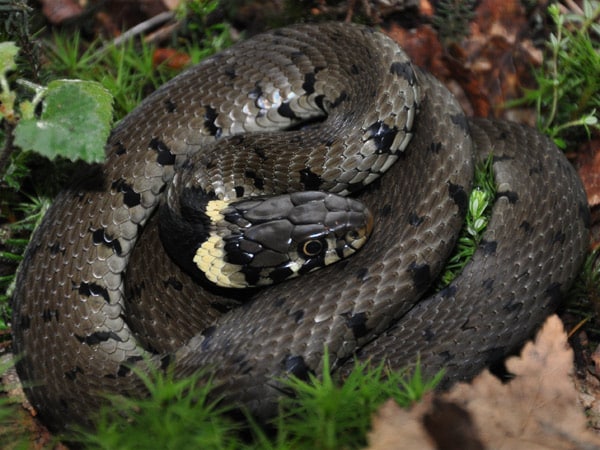Sophie Hinton, Amphibian and Reptile Conservation

© Chris Dresh
We are seven months into the year-long CLARE (Connecting London’s Amphibian & Reptile Environments) project and the partners* have been busy raising awareness of herpetofauna and generating a wider interest in wildlife recording in the capital.
There is a dearth of information on amphibian and reptile populations in London, especially reptile populations. CLARE has focussed on finding every possible source of information on the subject. Strategic surveys may appear to be the obvious route but CLARE has instead been taking advantage of another often over-looked source of information – the public.
At events, both large and small over the summer months, CLARE gathered information on sightings of London’s herpetofauna from the public. This process not only uncovered over 150 new records for London, but also inspired a wider audience to record all manner of wildlife, and share this with GiGL.
At one such event, two young herp-enthusiasts (a boy and a girl) recounted their first meeting with a slow-worm – and an earlier meeting with CLARE staff at the Thames Festival. Word-for-word, they repeated what they had learned from CLARE, including that slow-worms are not snakes but legless lizards, and were able to name all the common native amphibians that are found in London.
We hope that our presence at events like the Mayor’s Thames Festival will continue to be as successful in raising awareness long into the future.
The public has been and will continue to be an invaluable source of wildlife records. One advantage of collecting data in this way is that the recorded species can be validated at the event using photos and comparisons. This saves a lot of time later on during the validation and verification process.
While gathering data from the public, CLARE have been developing relationships with other organisations and local groups to encourage London-wide sharing of herpetological data.
As the spring of 2012 approaches, CLARE will re-focus efforts on surveying and actively gathering data. Knowing where to begin looking for small creatures in an area the size of Greater London is an issue that needs to be tackled before we can begin surveying. Thanks to GiGL’s vast database and modelling skills, we now know the best locations to focus our survey efforts.
Using the GLA’s open space habitat data, we assigned each habitat type a ‘likelihood of presence’ score for each amphibian and reptile species found in London. Together with existing herp data, these scores helped produce maps that show the top 10% most likely locations for reptiles and amphibians to occur within London. The likelihood of a particular animal occurring in a particular area increases if two or more suitable habitats fall within it.
When plotted alongside the existing herpetofauna records these maps reveal areas of potentially suitable habitat for which we have no records. It is these areas which CLARE will target for surveying.
These maps also highlight potential re-introduction sites, helping us to deliver on one of London’s Biodiversity Action Plan targets to increase the distribution of amphibians and reptiles in Greater London.
With help from volunteers and London Wildlife Trust staff, CLARE will set up a number of long-term monitoring programmes. Herpetofauna survey training will be provided this spring, improving the skills of a wider audience and increasing the availability of herpetofauna data in the future.
If you are interested in helping out on any surveys this year please get in touch with Sophie, CLARE Project Officer: e: Sophie.hinton@arc-trust.org t: 020 7261 0447/m: 07810 184 501 or tell us your sighting by visiting the CLARE webpage.
*CLARE Project partners: Amphibian and Reptile Conservation (ARC), GiGL, London Wildlife Trust and London Amphibian & Reptile Group (LARG)
ARG UK Network
Jonathan Cranfield, Vice Chair ARG UK
The Amphibian and Reptile Group UK was established in 2005, following the renaming of the Herpetofauna Groups of Britain and Ireland and the formation of a new panel to coordinate the network of volunteer amphibian and reptile groups (ARGs).
The first amphibian and reptile groups were started in Surrey and Sussex in 1986. Today, there are over 60 groups or contacts across the UK, including 43 in England, ten in Scotland, six in Wales and five in other areas including the Isle of Man, Channel Islands, Northern Ireland and Eire. An estimated 1,000+ volunteers are involved in these county groups making ARGUK the grass roots of the UK herpetofauna conservation movement, and complimenting the work of the national charity Amphibian and Reptile Conservation the lead partner of the CLARE project.
One of the newest amphibian & reptile groups is the London group (LARG). As with many of the groups, LARG began with a few enthusiastic individuals keen to become actively involved in the reptile and amphibian conservation. In a short period of time the group has grown and taken on habitat management work, toad patrols and surveying. This band of volunteers has demonstrated a real enthusiasm for reptiles and amphibians in the capital.
The CLARE project has proven an ideal partner project for London group, and they have worked together on a number of events and activities throughout 2011, culminating in the UK’s first ever WildlifeXpo at London’s Alexandra Palace in October. This busy and exhilarating event attracted visitors from as far afield as Middlesbrough, keen to find out more about wildlife. The event stimulated plenty of interest from adults and children alike in reptile and amphibian ecology and conservation.
As an affiliated amphibian & reptile group, LARG is also able to apply for additional funds through the special ARGUK100% fund to help with habitat management and surveying. It can call on the support of experienced volunteers from neighbouring groups in Kent, Surrey, Sussex and Essex to provide field work training for London volunteers, and to help bolster and support the development of reptile and amphibian ecology and conservation in London.
Find out more at http://www.arguk.org
